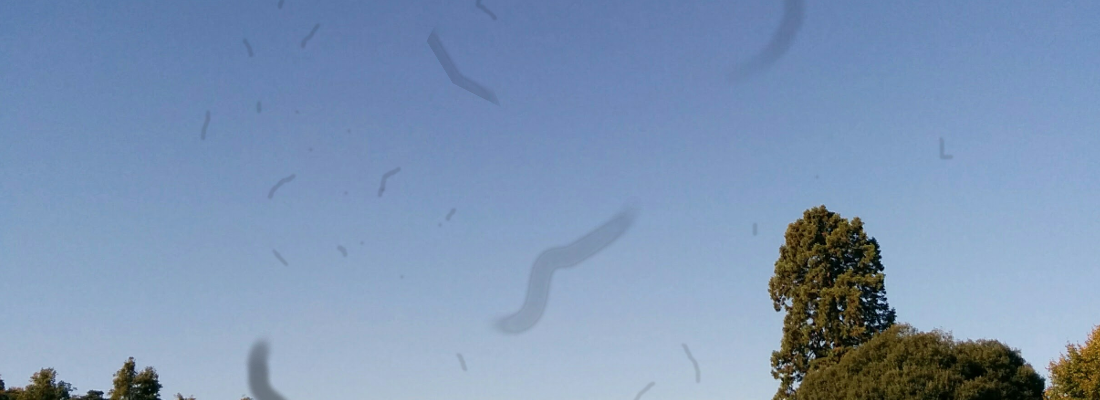Myths: Nothing can be done about floaters.
Facts: There may be treatment and prevention through proper diet and supplements.
Certain nutrients such as those found in the classic Chinese formula “Rambling Powder” and Milk Thistle Extract may help alleviate floaters.
Overview: Floaters are an appropriate name for these small dark shapes that appear before your eyes, because float through your field of vision is precisely what they do. They are clumps of protein. These spots may look like dots, squiggles, strands or any of a hundred other shapes. Though annoying, floaters are harmless, and there are ways to prevent them through proper diet.
Warning: If you suddenly become aware of new spots in our vision, see your eye doctor right away to rule out serious problems.
Symptoms: Little dots or dust floating around your eye.
Causes: Most floaters are the result of bits of cells that remain in the vitreous humor after birth and float around when the vitreous becomes more liquified later in life.
Over 50% of people over 70 years of age report seeing floaters. Most floaters are age-related. The vitreous humour thickens and clumps as we age, and floaters result from the clumped vitreous gel.
Other spots can be caused by little bits of protein trapped within the eye during pregnancy. Trauma to the eye or breakdown of the vitreous humour may also cause spots and floaters. Many floaters remain in the eye for long periods of time before they gradually disappear.
Floaters are commonly found in nearsighted people and people with food allergies and candidiasis.
Vitreous detachment is also common in diabetics, but the highest rate of complaints of floaters is in people over the age of 70. This is when the prevalence of a vitreous detachment jumps from 10% of the population to 63%.
From a Chinese Medicine perspective, floaters are an indication of congestion in the liver, kidney and colon. The herbs and nutrients we recommend below are chosen for their abilities to eliminate congestion in these organs in order to keep the vitreous of the eye clear from these annoying specks, as well as to help strengthen the retinal tissue and integrity of the blood vessels.
Finally, we believe chronic stress in one’s life may also play a role in the generation of floaters, so having a daily routine of relaxation and meditation is very important.
IMPORTANT NOTE: A sudden increase of floaters can be an indication of a vitreous or retinal detachment.
People who are very nearsighted and/or diabetic are particularly prone to floaters and retinal tears. If you suddenly new floaters, make an appointment with your eye doctor immediately. See “Drugs That Harm the Eyes” for a description of potentially harmful drugs.
Conventional Treatment: There is no specific treatment for floaters. In very severe cases, the doctor may consider doing a vitrectomy, in which the vitreous fluid is removed and replaced with an artificial gel.
There are a few eye doctors that are performing laser surgery for floaters, but one of the major criteria for one’s eligibility for this procedure is the location of the floaters in the vitreous fluid.
In one website, they described that most people that may be eligible for laser surgery would have had a post vitreous detachment (PVD), which sometimes pushes the floaters toward the middle of the eyes and away from the retina and lens.
This procedure has not yet been accepted by most of the medical community, probably due to the associated risks.
Complementary Treatment and Recommended Vitamins, Supplements, Herbs & Other Nutritional Products
- Essential: ReVision Formula for overall eye health
- Essential: Milk Thistle Liquid Extract 2oz
- Essential: Floater Homeopathic Pellets
- Very Important: Ethos MegaFocus™ 25 Super Nutrients for Optimal Eye Health
- Helpful: NanoGreens 10 (360 gm) 12.7 oz – organic green drink
- Helpful: MSM eyedrops permit better eye health
- Helpful: Carlsons Finest Omega-3 Fish Oil
- Care: An Encyclopedia on CD, authored by Marc Grossman, O.D., L.Ac. and Michael Edson, MS, L.Ac. This CD covers 29 major eye conditions including Floaters with specific nutrient, diet, exercise and juicing instructions by eye condition, plus much more.
- Daily juicing of vegetables and fruits (preferably organic). Our floater recipe is some combination of the following: garlic, parsley, beets, carrots, celery, parsnip, apple, raspberries (not too much fruit).
- For protein, emphasize fish, soy (in moderation), almonds, sunflower seed and sesame seeds. avoid meat, poultry, eggs, dairy products and most other nuts.
- Eat brown rice and other whole grains instead of refined and processed grains (such as white bread and pasta).
- Limit your intake of citrus fruit, particularly those high in vitamin C such as tangerines, kiwi fruit, oranges, lemons, papayas and pineapples.
- Use unsulfered molasses and fruit juices for sweetening instead of white sugar, chocolate or honey.
- Drink rice, almond or soy milk, herb tea or unsweetened, diluted from fruit juices instead of coffee, tea, alcohol and dairy drinks.
- Steam or bake foods instead of frying them.
- Eat lots of vegetables, but avoid the nightshade family(e.g., tomatoes, green peppers, white potatoes and eggplant).
- Minimize your use of salt.
- Try to manage your stress.
- Take up Yoga, Tai Chi, meditation, walks in nature, or prayer on a daily basis.
- Supplement your diet with a good multivitamin such as New Chapter Multivitamin Formula and/or and organic green drink daily such as Nanogreens
